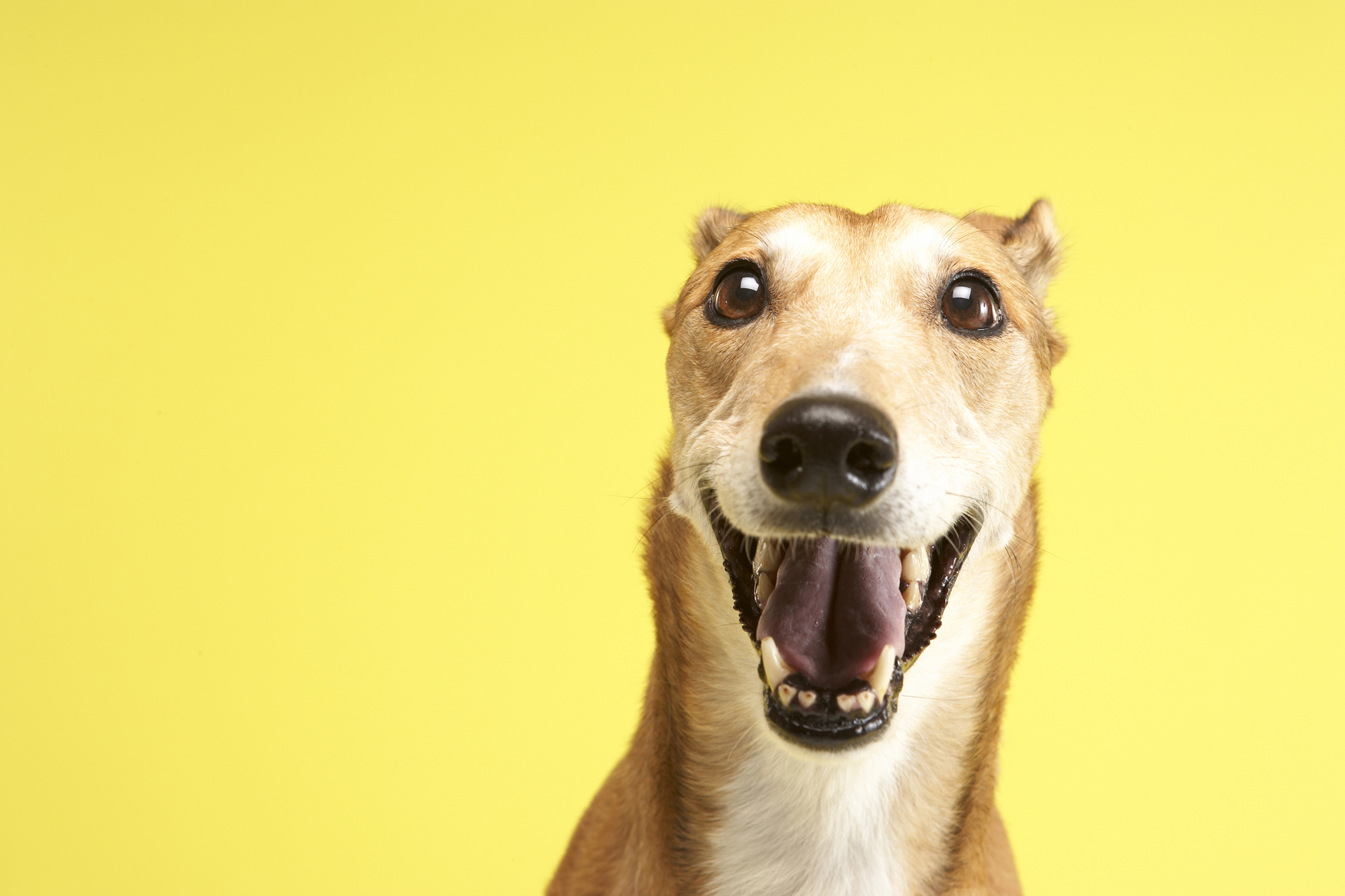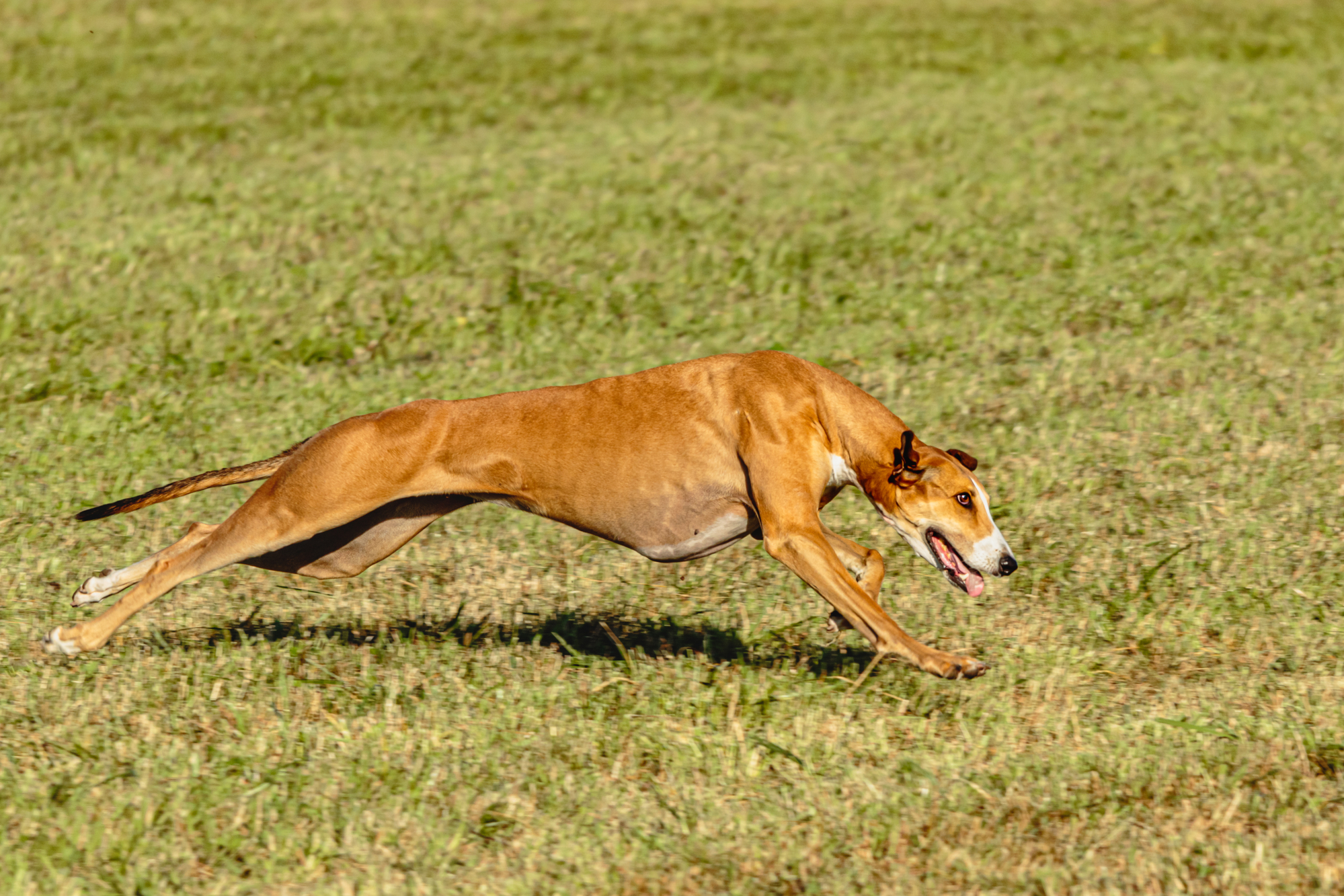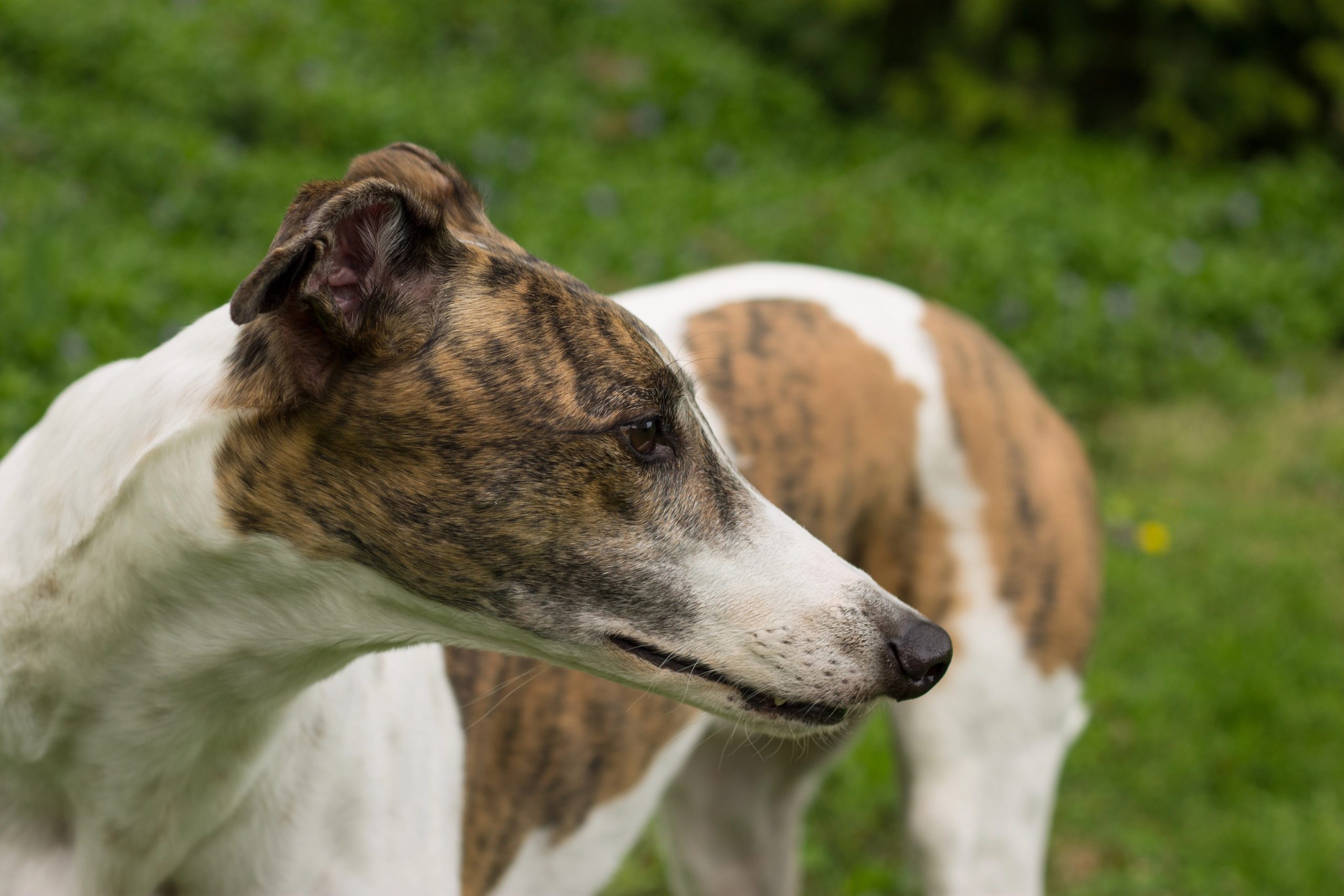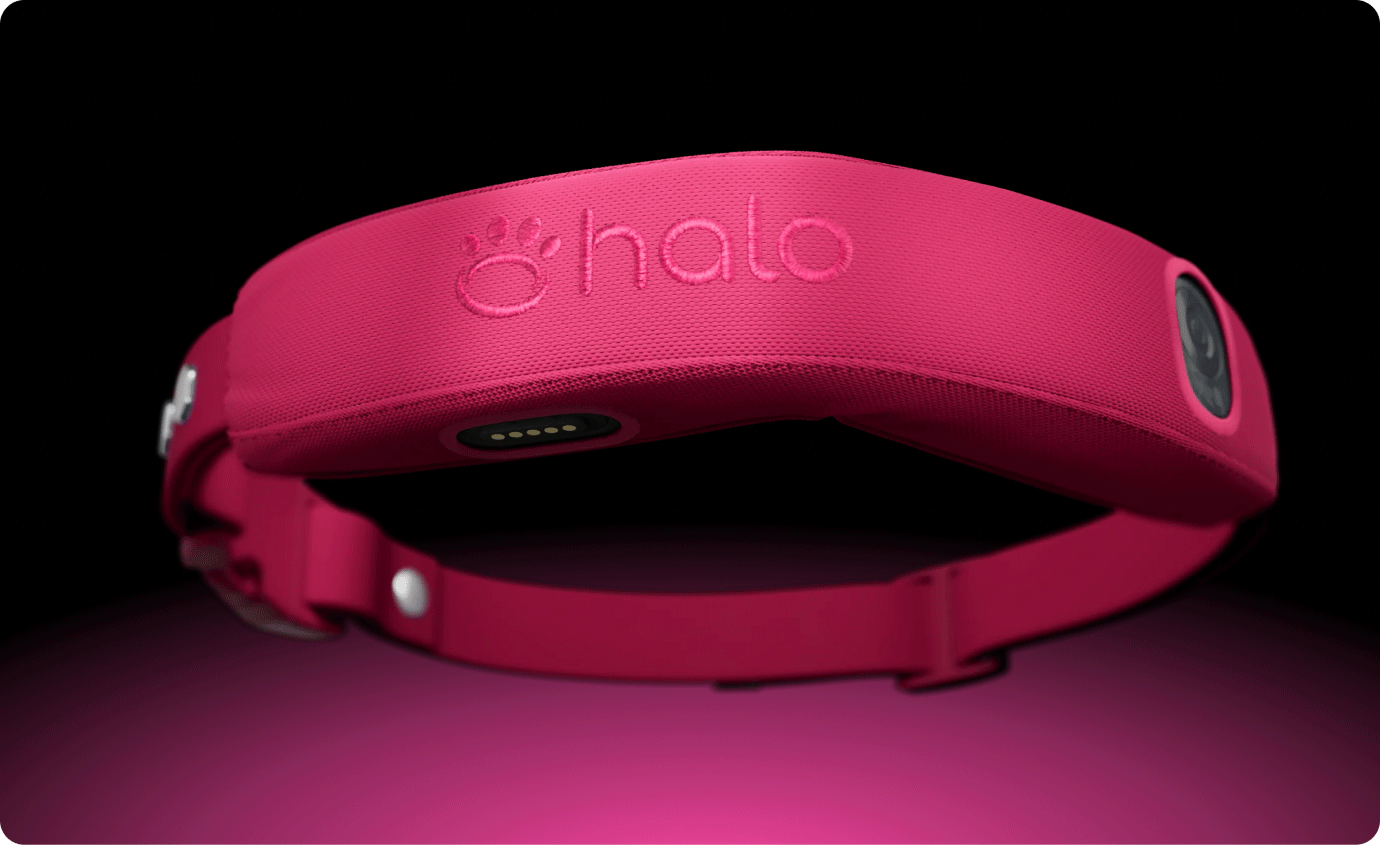Your Cart

Halo is backed by a 90-day satisfaction guarantee
Subtotal$0
Tax & Shipping Calculated at checkout
Total $0

Male: Weight: 65-75 lbs; Height: 28-30 inches
Female: Weight: 60-65 lbs; Height: 27-28 inches
Yes
Can coexist with cats if introduced to them and socialized as puppies
Yes
Use gentle, positive reinforcement
Weekly brushing, bathe once or twice a year as needed
10-13 years
Gentle, calm and nonaggressive
Smart and sensitive
Black, red, fawn, gray, white, brindle
Adjustable; Fits most dogs

Greyhounds were bred to hunt small prey and can run more than 40 miles per hour, earning them the title of fastest dog breed. Their distinctive physique matches this athleticism. Greyhounds are long and lean, powered by muscular legs that drive them forward. Their deep chests sit close to the abdomen, accommodating tall rib cages, and they have narrow waists and little body fat.
Greyhounds are considered large dogs. An adult male averages 28 to 30 inches in height and weighs 65 to 70 pounds. An adult female is slightly smaller, standing at 27 to 28 inches in height and weighing 60 to 65 pounds.
These sleek dogs have short, firm coats that are typically black, red, fawn, blue/gray or white. Some have a brindle coat, which features different color streaks over the base color.
When you first bring your greyhound home, give it plenty of space and time to get accustomed to its environment. This sensitive breed can be easily overwhelmed and needs its own safe, quiet area to retreat to.
Start early establishing a routine for meals, walks and bedtime. Dogs feel most secure when life is predictable and their needs are met. Your pet will respond better to training once you develop a trusted bond.
Gradually introduce your puppy to different sounds, smells and sights. Hold off on walks until it feels comfortable in its new home, as it can freeze when it feels overstimulated. Start by showing it your backyard and, eventually, venture down the block.
Puppies can begin to understand commands as early as 8 weeks of age. Start with essential commands such as sit and come. You might find it helpful to build obedience training into your routine; for example, you can start teaching your dog to sit at mealtime.
Use the same verbal cue for the desired response and speak in a clear, calm voice. Repetition and consistency are important, as you’re teaching your pet a new language. Everyone in the house should use the same command so your pet doesn’t get confused. It’s best to train your puppy in the same location each time and make sure the area is quiet and free of distractions.
Because of their sensitive nature, greyhounds may withdraw in response to harsh or forceful training approaches. Instead, keep your sessions positive and encouraging, and reward your dog enthusiastically with food, treats, pets or affection. Puppy training sessions are most productive if they’re limited to a few minutes.
It’s especially important to train your greyhound to come when called, no matter what age it is. Because they’re bred to give chase as soon as they see their quarry, there’s always a risk this instinct will kick in when they spot possible prey. Teach your pet to stop what it’s doing and come to you when called.
You can start teaching recall when it’s a couple of months old. Start by showing it a highly desirable treat and introducing the verbal cue. As you practice, gradually increase the distance between you and your dog. You can move from a low distraction area such as the house to a securely fenced area such as your yard.
A GPS dog fence is a great added layer of security when it come to keeping a Greyhound safe when off leash and can provide you with peace of mind, whether you are at home or you are out and about.
It’s often easier to teach puppies desired behaviors, as older dogs may be set in their ways. You can still train adult greyhounds using the tips described above, but it takes extra patience. It may also be especially challenging if your pet has come from an environment that’s made it hard for it to trust humans. Spend time establishing a bond and give it space if it seems overwhelmed. Use plenty of positive reinforcement.
Greyhounds have sleek, short coats and don’t require much grooming. Brush your pet about once a week and more frequently if it’s shedding. Regular brushing removes loose hair and dirt and distributes natural oils to keep the coat glossy. Because a greyhound’s hair is thin, use a soft-bristled dog brush instead of one with wire pins to avoid irritating its skin. You could also give it a gentle rubdown with a grooming mitt.
You only need to bathe your greyhound once or twice a year as needed to avoid drying out its skin. Use a mild dog shampoo and then towel dry. As a greyhound doesn’t have much body fat to keep it warm, wrap your pet in a blanket after bathing to keep it comfortable. If it gets a little dirty between baths, use a damp cloth to gently clean its short coat.
Your greyhound will also appreciate a regular nail trim for comfort. While its nails may wear naturally on walks, check them regularly and cut them if they’re touching the ground.
Schedule regular visits to the vet to make sure your greyhound is thriving and to catch potential signs of health problems. This breed is predisposed to a few conditions.
Greyhound polyneuropathy is a hereditary condition that may affect some dogs if both parents carry a certain gene. Genetic testing can identify carriers before breeding. This neurological disorder can cause progressive degeneration of the nerves, resulting in muscle weakness and loss of coordination. Affected dogs may show symptoms starting as young as 3 months.
Similar to other breeds that have a deep chest, Greyhounds are at higher risk of a condition known as gastric dilatation-volvulus or bloat. This occurs when a dog’s stomach fills with gas, fluid or food, causing it to twist out of shape. The abdomen will swell and become distended, and the dog will be in obvious discomfort. GDV is life-threatening and requires immediate medical attention. You can reduce the risk of bloat by feeding your pet smaller, more frequent meals rather than one large meal and avoiding vigorous exercise right before or after eating.

Your greyhound needs a nutritionally balanced diet, including essential vitamins, minerals, proteins, fats and carbohydrates. This supports its overall well-being, encouraging strong bones and joints and a healthy, glossy coat.
Since your canine companion isn’t racing or hunting, it doesn’t require a special diet to support physical exertion. Feed your greyhound a high-quality dry pet food, choosing a formulation based on its life stage. Puppy formulas are nutrient-dense to support rapid growth and development. Adult formulas typically have fewer calories than those for young dogs and are designed to maintain health and energy levels. Formulas for senior dogs may be easier to digest and have a lower calorie content to accommodate slower metabolisms and decreased activity levels.
Follow the feeding guidelines for the specific brand of dog food you’re using. The recommendations are usually based on your pet’s weight, but you can adjust this amount as needed. If your pet is particularly active, you can increase the amount based on its energy levels. Your veterinarian can assess whether your pet needs a special diet based on its size and weight.
Puppies should have three or four meals a day. Adult greyhounds should have two meals, one in the morning and one in the evening. To determine the portion at each feeding, divide the manufacturer’s recommended daily amount of dry dog food by the number of meals. Because of the risk of bloat, avoid scheduling meals right before or after exercise.
Provide your pet with access to plenty of fresh water so it can quench its thirst as needed. If your dog doesn’t drink much water, consider a wet dog food to add more moisture to its diet and help it stay hydrated.
While you might be tempted to feed your dog table scraps as a treat, its digestive system is different from that of humans. Fats, sugar, sodium and artificial sweeteners can cause health problems and add unnecessary calories to its diet.
Some foods are harmful to dogs. Don’t let your greyhound consume chocolate, avocado, grapes, raisins, onions, garlic, macadamia nuts or dairy products. Raw meat and eggs pose a risk because of possible bacteria such as salmonella or E.coli. Bones are choking hazards and can cause internal damage if they splinter.
There are some human foods you can safely share. Small pieces of unseasoned, cooked, lean meats such as beef, chicken, turkey or pork can be an occasional treat. You can also give them bite-sized pieces of carrots, green beans, broccoli and cauliflower. Veggies can be raw or cooked as long as they’re unseasoned. Apples, bananas, cantaloupe and blueberries are safe fruits, but be sure to remove seeds, stems and peels.
Greyhounds are intelligent dogs and enjoy mental enrichment. They may enjoy learning new commands and tricks. You can also keep them occupied with puzzle feeders that encourage them to forage. Playthings that mimic prey, such as squeak toys, flirt poles and rope toys, can stimulate their hunting instincts.
While known for their athleticism, greyhounds require only moderate exercise. Aim for at least 30 minutes of physical activity a day, ideally with a walk in the morning and later in the day. As coursing hounds, this breed may suddenly run if it spots a rabbit or small animal, so keep it on a lead.
Greyhounds tend to prefer sprints and short exercise sessions. They may need to build up their stamina if you’re looking for a companion for longer runs.
Miniature greyhounds — commonly known as Italian greyhounds — have the same sleek silhouette as their full-sized counterparts. They’re usually no more than 15 inches tall and weigh between 7 and 14 pounds.
Italian greyhounds were bred as aristocratic companions. They’re more attentive than standard greyhounds and are quintessential lapdogs. They get along well with dogs and young children and enjoy playtime or walks. Italian greyhounds share the same hunting instinct as full-size greyhounds and will give chase, so keep them close when outside.
These small dogs have a life expectancy of 14 to 15 years. They don’t require baths often but do require regular brushing, nail trims and daily dental care.

Greyhounds are a calm, gentle breed. They’re typically happy dogs with plenty of affection to share with their human companions. They’re not ideal guard dogs since they shy away from confrontation, but their nonaggressive personality makes them wonderful family pets.
Overall, greyhounds are clean and fairly low-maintenance. They only need occasional grooming and bathing, which makes them easy to take care of. They don’t need a lot of exercise, even though they’re known as racing dogs. Once they’ve had their walk or some play time, they’re often content to curl up with you while you watch TV or read. This means you don’t need a large house or yard. This breed is suited to apartment living as long as it gets outside for some exercise.
Greyhounds can get along well with children, especially if they’re socialized early. They’re also happy to hang out with other dogs. Their hunting instinct, however, kicks in around small animals. They may be better suited to homes without cats, rabbits, hamsters and other creatures they might want to chase.
For the most part, greyhounds can adapt to a variety of environments, from living with a big family in a house to sharing an apartment with a single owner. They’re quiet and sensitive, however, so they may prefer relaxed environments to ones that are constantly noisy or chaotic.
Most greyhounds are gentle and affectionate with children, although the unique personality of each dog comes into play. Puppies usually adapt well to kids when socialized early and enjoy the physical and mental stimulation provided by children. The compatibility of older greyhounds largely depends on how they’ve been raised and their temperament.
Like all breeds, however, greyhounds should be supervised around children. Teach your child how to approach your dog and treat it respectfully, and discourage rough play. With proper training and supervision, your child and dog can become wonderful lifelong friends.
Greyhound owners are often surprised to learn that these speedy, athletic dogs don’t need huge amounts of exercise. Most healthy greyhounds do well with 30 minutes of exercise a day, spread over two walks. Follow your dog’s lead, as some high-energy greyhounds may prefer more activity.
With their short, smooth coat, greyhounds have minimal grooming requirements. Use a soft brush or grooming glove once a week to remove stray hairs. This also stimulates natural oils to help keep their coat lustrous.
Bathing is only needed once or twice a year, or if your pet is dirty. Dry it with a towel after its bath and bundle it in a blanket to keep it warm.
Long or overgrown nails can cause pain when it’s walking. Check its nails regularly and trim them if they’re touching the ground.
Greyhounds are smart dogs and capable of learning commands with a gentle, consistent approach. Use positive reinforcement such as treats and praise to reward your pet.
One of the most important things you can teach your greyhound is to come when you call. This is critical when it gets distracted by possible quarry and runs off to chase it. Using a wireless GPS dog fence is a great way to ensure that your greyhound remains safe in your yard or when you are out and about.
Keep your pet healthy with regular visits to the veterinarian. Your doctor will make sure it’s up to date on its vaccinations and look for signs of potential health issues.
Some dogs can inherit a neurological disorder known as greyhound polyneuropathy. Affected dogs can show symptoms as early as 3 months. Fortunately, breeders can test for the mutant gene in the parent dogs so GHPN is less common.
Greyhound owners should also watch for bloat, or gastric dilatation-volvulus. This affects dogs with deep chests, such as greyhounds. Bloat occurs when the stomach fills with air and becomes twisted. This is a life-threatening condition. If your dog’s belly becomes hard and swollen, you should take your pet to the vet immediately. You can reduce the risk of bloat by feeding your dog smaller meals instead of one large one and avoiding exercise around mealtime.
A healthy greyhound usually lives between 10 and 13 years. However, factors such as nutrition, exercise, genetics and illness all affect longevity. You can help your greyhound thrive and lay the foundation for many years of companionship with proper care. Make sure your pet gets a balanced diet, plenty of exercise, regular health checkups and lots of love and affection.
Socialization plays a big part in whether greyhounds can live in homes with other pets. Typically, they get along well with other dogs. However, they have a strong predatory drive and want to catch small, fast animals. This can make it difficult to have pets such as cats, bunnies, guinea pigs, hamsters and mice in the same house. Greyhounds that are introduced to other animals when they’re puppies have a better chance of coexisting peacefully.
Greyhounds can adapt to most living arrangements. While a large, securely fenced yard is ideal for letting them run safely, they do well with regular walks and outings to a park. As sprinters, they usually expend energy in short spurts and then are content to lounge at home. As long as their indoor space offers a cozy place for them to rest, they can be just as comfortable in an apartment in the city or a house in the suburbs.
Greyhounds can be a good choice for a pet if you’re considering adopting a dog for the first time. They’re typically calm, gentle and easy to manage. They also require minimal grooming and exercise.
However, like all dogs, they need routines and training to encourage desired behaviors. While greyhounds are intelligent and relatively easy to teach, prospective dog owners should be prepared to invest time and patience in training. This includes house training, socialization, basic obedience and behavior modification.
Greyhounds need a well-balanced diet to meet their needs at different stages of life. A premium-quality dry dog food can provide essential nutrients to support their overall health. Choose a formula based on their age, whether they’re a puppy, adult or senior. As the nutrition and calorie content differs by brand, follow the guidelines on the package to determine how much to feed your dog.
The amount you feed your dog will vary by size and age. If your dog is highly active, for example, you may need to feed it a little more to support its energy level. Your veterinarian can provide recommendations tailored to your dog’s needs.

Dogs are truly man’s best friend, and you want to give your Greyhound the best life possible. Halo Collar is a wireless GPS fence with a convenient phone app that allows you to set up a safe perimeter for your dog at home, on walks, or anywhere you take your pup. It also acts as an activity tracker and training aid for your Greyhound, providing several convenient benefits in one. Shop for your Halo Collar today.

Halo is backed by a 90-day satisfaction guarantee
Subtotal$0
Tax & Shipping Calculated at checkout
Total $0